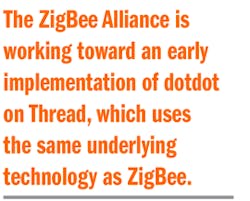Everything from thermostats, light bulbs, and smartphones would be able to talk wirelessly with each other using a new software language that the makers of ZigBee, the popular wireless standard for linking household devices, revealed on Tuesday.
The new language, which is called dotdot, is the latest attempt at desegregating Internet of Things devices, which still have trouble talking to devices built by different manufacturers or with different radio technology. The software, or application layer, aims to be a universal language that all devices can understand, whether they use Wi-Fi, Bluetooth, ZigBee, or other networks.
That contrasts with the current process of sending information through an internet gateway to the cloud, where it can be translated for different gadgets, like a Nest Labs security camera and a door lock developed with ZigBee. With a universal language like dotdot, the two devices could talk to each other directly.
The language is not completely new. It is just the latest brand for an application layer formerly known as the ZigBee Cluster Library, which has been used to connect the roughly 100 million devices shipped with ZigBee.
But the ZigBee Alliance behind the standard wants to make dotdot more generally useable. The application layer will include new specifications and a certification program. According to a statement, the first products are expected to be certified in late 2017.
“Recognizing the value of the evolving application layer that has been the core language of ZigBee devices for over a decade, market leaders within the alliance have come together to transform it into a universal language for the IoT,” said Tobin Richardson, the chief executive of the ZigBee Alliance, in a statement.
But for now, it will not work with much else unless other application layers are abandoned. There are many competing plans among chip suppliers and device makers to draft a similar universal language. In October, the Allseen Alliance and the Open Connectivity Foundation – two of the largest standards groups with members like Intel, Samsung, and Qualcomm – said that they would create an industry standard under the name IoTivity.
It is also not clear what other wireless technologies it might work with eventually. A spokeswoman for the ZigBee Alliance didn’t respond to a request for additional information.
To start, the ZigBee Alliance is working toward an early implementation of dotdot on Thread, which uses the same underlying technology as ZigBee. The effort quietly started over a year ago when the ZigBee Alliance agreed to share its software language library with the Thread Group, which was founded in 2014 with many of the same members.
The first results of that partnership are being displayed at CES, formerly known as the Consumer Electronics Show, in Las Vegas this week. The companies that will show dotdot products include Osram Opto Semiconductors, NXP Semiconductors, Schneider Electric, and Silicon Labs.


